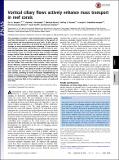Vortical ciliary flows actively enhance mass transport in reef corals
Author(s)
Shapiro, Orr H.; Guasto, Jeffrey S.; Kramarsky-Winter, Esti; Vardi, Assaf; Stocker, Roman; Fernandez, Vicente Ignacio; Garren, Melissa S.; Debaillon-Vesque, Francois P.; ... Show more Show less
DownloadShapiro-2014-Vortical ciliary flo.pdf (2.161Mb)
PUBLISHER_POLICY
Publisher Policy
Article is made available in accordance with the publisher's policy and may be subject to US copyright law. Please refer to the publisher's site for terms of use.
Terms of use
Metadata
Show full item recordAbstract
The exchange of nutrients and dissolved gasses between corals and their environment is a critical determinant of the growth of coral colonies and the productivity of coral reefs. To date, this exchange has been assumed to be limited by molecular diffusion through an unstirred boundary layer extending 1–2 mm from the coral surface, with corals relying solely on external flow to overcome this limitation. Here, we present direct microscopic evidence that, instead, corals can actively enhance mass transport through strong vortical flows driven by motile epidermal cilia covering their entire surface. Ciliary beating produces quasi-steady arrays of counterrotating vortices that vigorously stir a layer of water extending up to 2 mm from the coral surface. We show that, under low ambient flow velocities, these vortices, rather than molecular diffusion, control the exchange of nutrients and oxygen between the coral and its environment, enhancing mass transfer rates by up to 400%. This ability of corals to stir their boundary layer changes the way that we perceive the microenvironment of coral surfaces, revealing an active mechanism complementing the passive enhancement of transport by ambient flow. These findings extend our understanding of mass transport processes in reef corals and may shed new light on the evolutionary success of corals and coral reefs.
Date issued
2014-09Department
Massachusetts Institute of Technology. Department of Civil and Environmental EngineeringJournal
Proceedings of the National Academy of Sciences of the United States of America
Publisher
National Academy of Sciences (U.S.)
Citation
Shapiro, Orr H., Vicente I. Fernandez, Melissa Garren, Jeffrey S. Guasto, François P. Debaillon-Vesque, Esti Kramarsky-Winter, Assaf Vardi, and Roman Stocker. “Vortical Ciliary Flows Actively Enhance Mass Transport in Reef Corals.” Proceedings of the National Academy of Sciences 111, no. 37 (September 5, 2014): 13391–13396.
Version: Final published version
ISSN
0027-8424
1091-6490